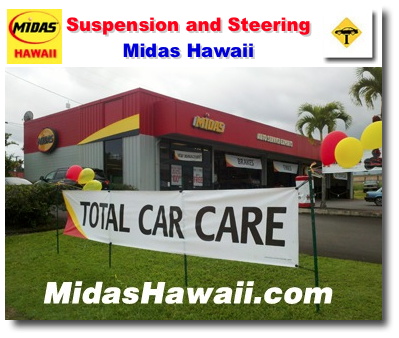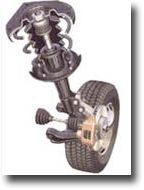Suspension and Steering - Auto Repair & Service
- Tweet

Suspension and Steering - Auto Repair & Service
Does your car dip or rock when you go over bumps or drift around corners even at low speeds?
If you answered yes, it may be time to replace your vehicle's shocks or struts.
To maintain control of your car, the wheels need to be in firm contact with the road at all times. Pulling, bouncing, and uneven or excessive tire wear and poor steering control are all symptoms of steering, suspension, or alignment problems. Whether your vehicle has a conventional suspension system with shock absorbers or a strut-based system (which is typical in many front-wheel-drive cars), your local Midas shop has the know-how to diagnose and repair any problem. We also have the equipment necessary to correct any alignment issues we might find.
Shock absorbers and strut assemblies work with the suspension, springs and tires to make your vehicle ride smoother over rough roads. They help reduce the bounce on the wheels, making the ride safer.
 Today's front wheel drive automobiles are equipped with new suspension systems that combine lighter weight with more durable performance. When any of these suspension systems need service, it is important to take care of them immediately or your vehicle can become hard to steer and control, and your tires will wear out sooner.
Today's front wheel drive automobiles are equipped with new suspension systems that combine lighter weight with more durable performance. When any of these suspension systems need service, it is important to take care of them immediately or your vehicle can become hard to steer and control, and your tires will wear out sooner.
One indication that your suspension needs service is uneven wear on your tires. If the steering wheel binds or drags when you turn it, you could have a rack and pinion problem. Clicking or clacking noises, especially when turning sharply, are symptoms of CV joint problems.
Midas Suspension specialists are fully qualified in the latest Suspension diagnostics and technology. They will inspect your entire suspension system, including rack and pinion steering gear, struts and CV joints. Then they'll give you a written estimate before any work is performed.
FAQ LEGEND
Back to the top
Steering & Suspension Questions
A. Your steering and suspension systems work together to keep your tires on the pavement and your vehicle under control -- until a power steering problem makes your steering wheel hard to move, or a suspension problem makes you whole vehicle hard to rein in.
If your vehicle bounces, sways, squeaks, or makes you work hard just to turn the steering wheel, request a diagnostic appointment. Our Midas Auto Service Experts® will conduct a thorough inspection of your steering, suspension, and other possible causes for your vehicle handling problems. We'll take the time to explain your vehicle's condition, and let you know which services are urgent (and which can wait). We discuss the best options for your budget and provide a written estimate before making any repairs.
Suspension Service
Most drivers wonder about their vehicle's suspension when the ride gets rough. But that bounce and squeak isn't the only way a bad suspension can spoil your ride.
Does your car lean into turns a little a little too forcefully? Does the back of your vehicle drag when you accelerate? Does the front take a noticeable nosedive when you brake?
With a damaged suspension, it feels like you've lost a little bit of your control over your vehicle. Listen to that instinct -- the lean, the drag, and the nosedive are warnings of heightened rollover risk and increased stop time.
Related:
Wheel Alignment -- The suspension service that goes hand in hand with your tire maintenance routine.
A. A bad suspension leaves visible signs if you know where to look, but the change in your vehicle's handling will probably catch your attention first.
Signs of a damaged suspension that you can see and hear:
- One corner of your vehicle sits lower than the others. Suspect a broken spring.
- Your vehicle fails the "bounce test": Lean your body weight on the front of your parked vehicle and then move away quickly. If the vehicle bounces more than twice, suspect a problem with your shocks and struts.
- Your tire treads develop a specific, uneven wear pattern called "cupping."
- You see oil, grease, or obvious wear on your shocks or struts.
- You hear squeaking, especially when turning or braking.
Here are several symptoms of a damaged suspension that you can feel as you drive:
- Your ride feels rougher than usual.
- Your car leans forward, backward, or toward one side as you brake.
- Your vehicle pulls or drifts, especially around turns. The prime suspect: bad shock absorbers.
- Your vehicle pulls or drifts while driving straight. The cause could be your suspension -- or your steering, your tires, or your brakes. Rule out uneven tire pressure, then see a mechanic.
Here's a tip that just may save you a trip to Midas. (We won't take it personally.) Some signs of steering and suspension problems are really brake and tire problems in disguise. So, at the first sign of trouble, check your tire pressure and tread wear. Your suspension is designed to work with four correctly-inflated tires, ideally of the same age and tread life. If optimal tire pressure doesn't fix the problem, make your diagnostic appointment.
A. Driving with a bad suspension is likely more dangerous than driving with a suspension in good shape. The suspension contributes to your vehicle's road traction and resistance to centrifugal force when turning and braking. Depending on the suspension problem, you could face increased risk of rolling over, or find yourself unable to stop as quickly as you expect in an emergency.
A. Some common signs of a power steering problem are:
- Noise when turning the steering wheel: A loose drive belt can squeal, and a bad power steering pump can clatter.
- Change in steering response: A stiff or slow-to-respond steering wheel can also point to a bad power steering pump.
- Vibrating steering wheel: A loose belt or power steering pulley.
- Low or dirty power steering fluid: Oxidation, metal flakes, or bubbles can mean air in the power steering fluid lines or a bad power steering pump.
A. Power steering problems are typically caused by:
- Worn power steering pump.
- Contaminated power steering fluid: A side effect of problems with the power steering pump and hoses.
- Low power steering fluid pressure: Caused by leaks or air in the power fluid lines.
- Loose or broken drive belt: A completely broken serpentine-style drive belt will disable too many systems to operate your vehicle, but a drive belt issue localized to your power steering pulley can compromise your power steering alone.
ref no:9550
Please send questions about this website to webmaster
Terms of Use / Legal Disclaimer / Privacy Statement
Site Designed and Managed by MacBusiness Consulting

